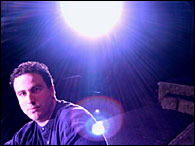Kaleidoscope
Keith Roche: Man behind the action
 |
|
He's behind every light, set and sound featured at Moyse Hall. His title is assistant technical production manager, but Keith Roche can also be called a backstage do-it-all.
Indeed, as part of his job, Roche works as carpenter, electrician, sound technician, lighting expert and teacher. His ability to multitask means every Moyse Hall play or lecture is delivered without a hitch.
Roche even works outside Moyse Hall when his job calls for it. One recent call had him driving his van westward to Kingston, Ont., to pick up an antique wood-burning stove for a production of Dancing at Lughnasa. Roche says travelling such a distance for a stove was worth it, since the prop was a steal at $50 and serves as a focal point of the play, which is being presented at Moyse Hall by the Department of English Drama and Theatre Program Nov. 7 to 9 and 14 to 16.
"What's great about my job is how it changes all the time," Roche enthuses, nodding towards the stage and stove. "There's never a dull moment."
Roche recalls being keen on working behind the scenes long before he graduated from Montreal's National Theatre School in 1996 - the same year he was hired at McGill. "I never had an inkling to be on stage myself," he says. "I'm a hands on, technical kind of guy, so working as a technician seemed like cool work."
It's obvious Roche takes pleasure in his job. That's why for the last year he's been transmitting his love of theatre back to his alma mater by teaching a part-time course called "Introduction to Sound."
"It can be challenging teaching people basic sound design," he says. "Sound is not like lighting, where you can see what works. With sound, you have to be able to listen and manipulate boards with a thousand knobs and buttons. It can be intimidating."
Roche routinely imparts his technical know-how to McGill students, too. Since many of the plays produced in the hall are student-run, he supervises their work and teaches them everything from how to arrange a spotlight to the art of fabricating a stone wall out of styrofoam.
"It can be complicated to transmit some things," he says. "But I really push the educational side of my job - for the students to learn as much as they can. It might take a little longer for sets to be built, but it still gets done by the students themselves."
Another critical element Roche shares with students - by example - is how to keep calm under the pressure of live theatre. He remembers an incident during a presentation of The Gondoliers where a spotlight caught fire because of its melting plug, sending a plume of smoke throughout Moyse Hall.
Within minutes he managed to climb the backstage skywalks, locate the smoking fixture and turn off its breaker. The show continued uninterrupted. "I was lucky, it only took a few minutes to locate the spot," he recalls. "Those were tense moments."
One smoky spotlight, however, is pretty much the only problem Roche has thus far encountered at Moyse Hall. He only praises the subrbly equipped venue during a tour of the backstage, dressing rooms and his workshop.
The 306-seat venue's ideal conditions mean it's often in heavy demand during the academic year, although groups such as the Just for Laughs Festival rent out Moyse Hall for rehearsals or its workshop to build sets in the summer. But during the academic year the venue is often solidly booked.
Roche says the hall is now featuring more high-profile talks, including a forthcoming Massey Lecture by Margaret Visser on Nov. 13. Visser's visit, however, happens to be between presentations of Dancing at Lughnasa. That means the set will be partially dismantled for the talk. "The only thing that we won't be able to remove is a tree," Roche says.
Because of Moyse Hall's popularity, Roche often finds himself working beyond a traditional 9 to 5. "Often, everybody wants everything at the same time," he says, adding that means he sometimes finishes at midnight or 2 am on production nights.
Roche doesn't mind the odd hours, since backstage work is often fleeting. "A lot of people in my position go from job to job and show to show, sometimes working in theatres with (bad) equipment," he says, counting his blessings. "I get to work in a state-of-the-art theatre."
 |
||||
|
Trashing candidates is American as apple pie. Mudslinging is almost as old as politics, and complaints about mudslinging are as old as mudslinging. |
||||
Foundations
 |
|
Smoke for health
It was 1937 and the Great Depression continued to cast a pall over Canada. At McGill, the return on university investments fell 44 percent from 1927 to 1934. Donations were down and budgets tight across the board.
McGill desperately needed a new gymnasium - a project that had been first proposed in the 1800s. How could funds - $350,000 in all - be raised?
The answer came in packs of 10, 20, 25 and 50. McGill brand cigarettes - complete with the University logo - were sold for years and led to the construction of the Currie Gym. The cigarettes were Macdonald tobacco's contribution to the new gymnasium - which was also needed as a winter training facility for the Canadian Officer Training Corps. The tobacco giant agreed to split the profit from every pack sold with McGill.
Elizabeth Shapiro, currently a volunteer in the McGill archives, was a student at the time, living in Royal Victoria College.
 |
|
"I learned to smoke at McGill," she said. "I would make a point when I went home to New York to visit of casually throwing my pack of McGill cigarettes on my mother's end table - people would always be impressed by the red and white packages.
"I always used to get them at Ben's on University - Ben was like a second father to the girls in RVC. You could get them one for a penny there," said Shapiro.
The advertisements for McGill cigarettes showed fresh-faced, stylish young people in outdoorsy locations - no sillier than the idea of selling smokes for a health facility.
Shapiro recalled that the chance to help contribute to the university was incentive to take up the habit - that, and "all the movie stars smoked." As one McGill News ad said: "Your continued purchases of these cigarettes will do much to make possible the building of McGill's gymnasium in its entirety."
Shapiro noted the warden of RVC in the 1930s was very concerned about the evils of smoking and its effects on her charges.
"Keep in mind this was the 1930s and I was female. It was 'Well, who does she think she is?' This was very unladylike - you were a fast woman if you were caught with a cigarette dangling."
Of course, Shapiro seems to have been a bit of a rebel - she became McGill's first cheerleader during her time here - something for which she was lectured by the Principal.
"We kind of resented it - Queen's and Western had female cheerleaders. McGill just wasn't 'with it,'" she said. Shapiro was pleased to have been recently honoured by the football team for her trailblazing - she was presented with a football jersey at the last game against Bishop's.
 |
|
Almost 84, Shapiro now gets around with a cane, her cheerleading days behind her. Her smoking days are over too - she quit a few years ago, after more than six decades.
"I just woke up one morning and I said to hell with it, and that was that!," she said with a laugh.
 |
||||
|
If you don't have to hold your breath (when you lift the snow) then the level you are working at is clearly okay. |
||||

